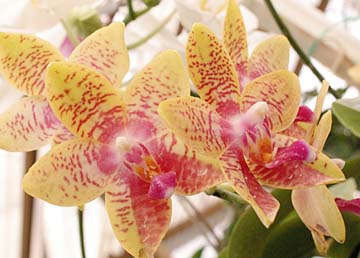


Home & Garden![]()

|
PRofessor Yoneo Sagawa, whose expertise in orchid cultivation is world famous, has this relieving piece of advice: "Don't worry about killing an orchid. If you happen to kill the plant, just throw it out and go to the store and buy another one. You'll be helping the orchid industry." Butterfly orchids now
outsell lady slippersA famed horticulturist resumes his
popular tours of potted bloomsIf you are among the lucky two dozen people who are assured a space on a tour of his orchid greenhouse Thursday at the University of Hawaii's Magoon Research Facility, you'll hear that unexpected advice with your own ears.
Sagawa, a horticulturist at the university whose expertise is sought by commercial orchid growers worldwide, is once again offering his annual tour through Lyon Arboretum, a UH research facility. The tour focuses on phalaenopsis orchids, or butterfly orchids, which are coming into peak bloom.
The tour, about two hours long including travel time, has been popular with gardeners but was canceled last year due to the university faculty strike. When the tour was back on the schedule in the arboretum's Stepping Stones to Good Gardening classes this year, it was filled to the maximum of two dozen people.
Call the arboretum to be placed on a waiting list or notified of upcoming tours. The classes are arranged through the Garden Club of Honolulu, the arboretum and the arboretum's volunteer association.
Sagawa is accustomed to the oohing and aahing during the tour. The Magoon greenhouse is home to many different orchids, and the phalaenopsis occupy only eight tables, but the tour offers a glimpse of many different types of phalaenopsis.
There are species plants -- collected from the wild or propagated from wild plants -- that have humble, small flowers, but each plant may cost hundreds of dollars because of its rarity. Then there are the more familiar-looking hybrids with large blooms that resemble white butterflies or moths.
Phalaenopsis Orchids (butterfly orchids) Orchid show
Featuring: A tour of the University of Hawaii's Magoon Research Facility with renowned orchid horticulturist and University of Hawaii professor Yoneo Sagawa
Place: Tour offered through Lyon Arboretum, 3860 Manoa Road, where the group will carpool to the nearby greenhouse
Time: Next Thursday's tour is filled. Call the arboretum to be placed on a waiting list or to be notified of upcoming tours.
Cost: $8, $7 for members
Call: 988-0456
"Phalaenopsis has become the most popular potted orchid," surpassing the more exotic-looking lady slippers, Sagawa said. Phalaenopsis is noted for its beautiful, long-lasting blossoms once popular in wedding bouquets. The hybrid flowers are large and bloom progressively -- with flowers opening in succession, starting from the bottom of the stem and gradually moving to the tip -- ensuring a long blooming period.
Phalaenopsis is compact, and sometimes its leaves are mottled so that it remains a handsome plant without the graceful long, curvy stalk of blooms. It tolerates low light and requires little humidity. All those characteristics translate to an ideal indoor plant, making it a popular feature on office desktops and home coffee tables.
Caring for phalaenopsis isn't difficult. As with all orchids, water generously but only when the potting mix is dry to the touch. Use fertilizer formulated for orchids or house plants, carefully following instructions.

|
One important tip, Sagawa said, is never repot an orchid when it is dormant, or you'll guarantee its untimely demise. Check the plant for signs of new growth; if it has new growth, then it's safe to repot. A new growth may be an emerging leaf or shoot.Phalaenopsis blooms range from white, yellow, a variety of pinks to combinations of colors. White-flowered phalaenopsis remain a popular choice in America, but elsewhere tastes vary, Sagawa said. The Japanese prefer pastel colors while the Chinese like riotous yellows and pinks, and the dark pinks are in demand in Europe.
Sagawa's research involves breeding orchids to bring out marketable traits. For example, he and his assistants are working on creating a compact plant with a shorter flower stalk, suitable for small spaces, such as an office. One of his experiment is blooming for the first time.
"It's hard to say what is the ideal phalaenopsis. It depends on the market we are breeding the plants for. We always have to establish a purpose first," Sagawa said. The purpose may be a longer blooming period, specific colors, size of flowers, stronger scent and other criteria.
Sagawa is noted for his pioneering technique in orchid micropropagation, a cloning method that allows infinite copies of a mother plant. His fame has brought students from around the world to study with him at the university.
Sagawa's cloning method, meristemming, involves propagation from the growing tip of a new orchid shoot. The shoot is stripped of its skin layers, leaving the shoot tip, which is about the size of a stick of lead in a pencil. The shoot tip then is disinfected and put in a liquid culture containing hormones and nutrients to encourage clone growth.
The method allows for preservation of orchids for research and efficient propagation for commercial purpose. Sagawa currently is taking part in a three-year research project to fingerprint orchids through their DNA. The project is sponsored by the Korean government and a collaboration with Korean researcher Mi-Seom Kim and Hawaii professor Clifford Morden.
For another look at orchids, visit the Kunia Orchid Society Show today through Sunday in the Del Monte Kunia Gymnasium in Kunia Village. See the garden calendar at left for details.
BACK TO TOP
|
[GARDEN BRIEFS]
Isle garden designer wins honors
Honolulu landscape architect Leland Miyano has been named recipient of the Mrs. Oakleigh Thorne Medal award from the Garden Club of America.Miyano, the second from Hawaii to receive the prestigious award, will be honored during a dinner at the garden club's annual meeting April 9 in Dallas. A garden club spokeswoman said Miyano was chosen for his achievement in garden design and devotion to preservation of Hawaii's natural environment.
Miyano, trained as an artist at the University of Hawaii, came under the tutelage of noted garden designer of Brazil, the late Roberto Burle Marx. Held by their common interest in plants and preservation, they went on rescue missions into the rain forests of Brazil and Southeast Asia in the search and rescue of endangered plants.
Miyano also is a writer, avid hiker and amateur researcher of fossil of Hawaiian endemic terrestrial mollusca and taphonomy. His outstanding landscape designs and exhibits have won him awards and an honorary membership with the Garden Club of Honolulu.
For 20 years, Miyano has maintained a 1-acre garden in Kahaluu that also serves as his experiment facility. His garden was the subject of a cover article in the Star-Bulletin June 1 last year, and has been featured in national television shows and publications. The garden has evolved from bromeliads, palms, cycads and other tropical plants to a focus on Hawaiian species as Miyano became interested in native plants.

|
Lilies for Ability
Make your home greener, and do a good deed in the process.Easter Seals Hawaii is taking orders for its annual "Easter Lilies for Ability" sale. This is the fourth year for this signature event, which has raised more than $20,000 for Easter Seals programs for disabled children and adults.
The cost is $10 ($4 tax deductible) per plant. Order 15 or more plants, and Easter Seals will deliver the lilies to the address of your choice.
Foodland, a sponsor of the event, will have lilies on sale statewide, and Easter Seals will receive $1 from each plant sold in the Foodland stores.
The Easter lily, a symbol of spring, was officially incorporated as Easter Seals' logo in 1952 for its association with new life and has appeared on each Easter Seal ever since. In 1999, Easter Seals Hawaii established the "Lilies for Ability" campaign, identifying that association as its foundation.
To order, call 536-1015.
Circle meets in Kailua
The Lanikai Garden Circle will host its monthly meeting beginning 9 a.m. Tuesday in the Kailua Library fountain courtyard, 239 Kuulei Road.Discussions open to the public will include information about gardening books available at the library, plans for the fountain area and a discussion of members' gardening problems.
The Garden Circle, part of the Lani-Kailua Outdoor Circle, gives those starting new gardens or revamping old ones, and other interested gardeners an opportunity to learn something new. For details, call 261-5265.
Gardening Calendar
Suzanne Tswei's gardening column runs Fridays in Today.
You can write her at the Star-Bulletin,
500 Ala Moana, Suite 7-210, Honolulu, HI, 96813
or email stswei@starbulletin.com